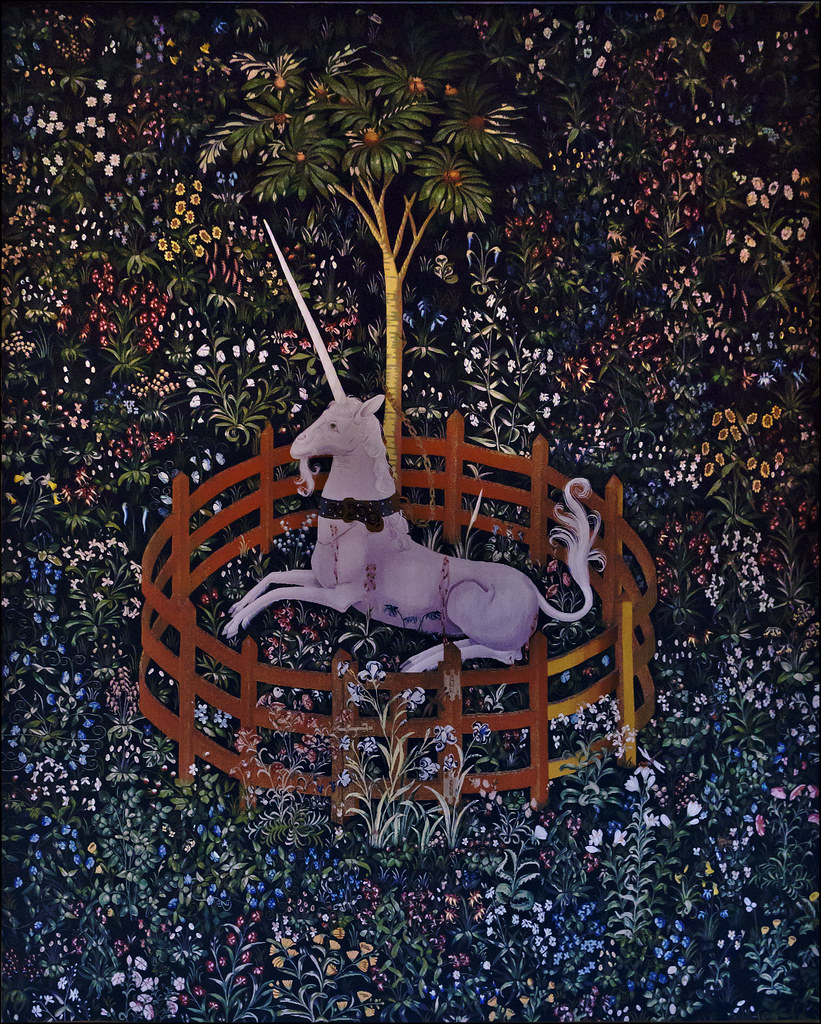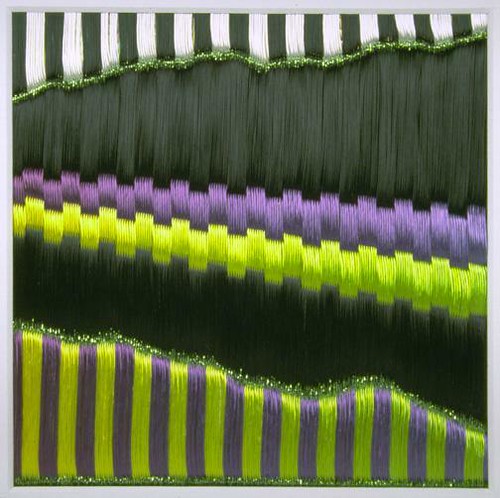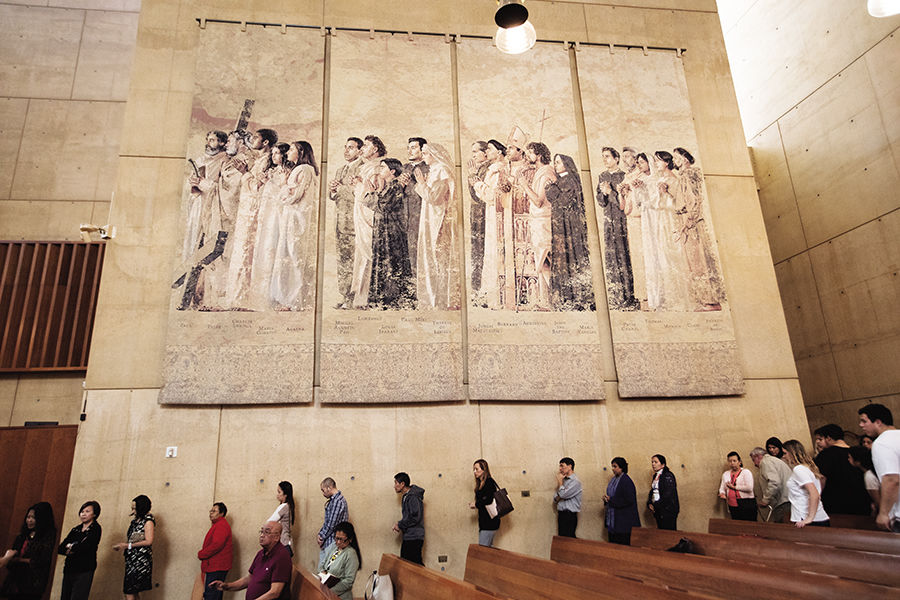Tapestry is a form of textile art, woven on a vertical loom, in which all the warp threads are hidden in the completed work, unlike the weaving of fabrics in which both the warp and weft threads are visible.

Images source: https://search.creativecommons.org/photos/0cda8b44-0206-4909-b650-e3a6c0796ae8 by dun_deagh
What materials are used to make tapestries?
Wool was the most used material to make the warp, that is the parallel series of threads that run lengthwise in the tapestry fabric. The wide, weft, or filler threads, which are passed at right angles above and below the warp threads, covering them completely, are also more commonly woolen. Wool has often been used for the weave in combination with linen, silk, or cotton threads which can give a greater variety and contrast in color and texture and are more suitable than wool for weaving details or creating delicate effects. In European tapestry, light silks were used to create pictorial effects of tonal gradation and spatial recession.

Image source: https://search.creativecommons.org/photos/77c35d81-4c74-41ae-9581-d78c9c853d3c by MShades
Most Chinese and Japanese tapestries have both warp and weft silk threads. Tapestries entirely of linen were made in ancient Egypt, while Copts, or Egyptian Christians, and medieval Europeans sometimes used linen for the warp. Cotton and wool were used for pre-Columbian Peruvian tapestries and some tapestries made in the Islamic world during the Middle Ages. Since the 14th century, European weavers have used gold and silver weft threads along with wool and silk to achieve a sumptuous effect.
What are Middle Ages tapestries working techniques?
The tapestry is first of all a technique. It differs from other forms of patterned weaving in that no weft thread is carried across the entire width of the fabric web. Each unit of the pattern or background is woven with a texture, which is inserted back and forth only on the section where that color appears in the design or cardboard. The weft threads pass alternately above and below the warp threads and on the return go under where they used to be above and vice versa. Each step is called a pick, and when completed the textures are pushed firmly together by various devices (pointer, rod, cue, comb, or serrated nail in Japan). The weft threads are more numerous than the warps which completely hide them. The warps in a finished tapestry appear only as more or less marked parallel ridges in the weft.

image source: https://search.creativecommons.org/photos/d36ed286-363f-4452-99ff-7cf164d66b70 by US Embassy Canada
The thickness of the warp affects the thickness of the tapestry fabric. In Europe during the Middle Ages, the thickness of the wool tapestry fabric in works such as the 14th-century Angers Apocalypse tapestry was about 10-12 threads per inch (5 to the centimeter).

image source: https://search.creativecommons.org/photos/80a13d5b-45e1-406a-8acf-5c1b438c8c24 by Rusty Clark ~ 100K Photos
How tapestries are related painting?
Tapestry has a close relationship with painting, moreover, some of the best tapestries were designed by famous painters. Unfortunately, this connection has often cast a shadow over the medium in immeasurable ways. Some have seen tapestries as mere copies of paintings or as interior furnishings, leading viewers and art historians to overlook or consider them of lesser importance.
Since the tapestries are made of flexible fiber, they can be rolled up and easily transportable compared to framed paintings. This flexibility allowed royalty, nobility, church dignitaries, and other wealthy tapestry owners to take pieces with them on their travels. The tapestries worn this way were relatively small with biblical images used as votive images for daily prayer and moments of personal reflection.
The larger tapestries, on the other hand, were hung in castles, abbeys, and palaces for decoration and to line drafty halls and rooms in an era before central heating. For major state and religious ceremonies, tapestries were also hung outside buildings, suspended from balconies, or attached directly to outside walls along the streets.
Tapestry quality characteristics
The quality of a tapestry depends on four variable factors: the quality of the cardboard from which it is copied; the skill of the weavers; the fineness of the weft (the number of warps per centimeter and the degree of weft); and the quality of the materials. The cost of a tapestry, in the late Middle Ages and the Renaissance, varied according to its quality. The production required the participation of many skilled weavers for the execution of large tapestries.
What are the most important tapestries during Middle Ages?
At the end of the 8th century, some documents found describe tapestries with figurative ornaments that decorated churches and monasteries in western Europe, unfortunately, no examples remain, and the ambiguity of the terms used does not give certainty of the technique used. The 11th-century so-called Bayeux Tapestry depicting the Norman Conquest of England is a crew embroidered tapestry.
From the early Gothic period in the 13th century to the 20th century, the Western European tapestry flourished. Few pre-Gothic tapestries have survived. The hanging for the choir of St. Gereon’s church in Cologne, Germany is perhaps the oldest preserved tapestry in medieval Europe. This seven-color woolen tapestry was probably made in Cologne in the early 11th century. The medallions with bulls and griffins locked in combat were probably adapted from Byzantine or Syrian silk fabrics. The Cloth of Saint Gereon is ornamental, but an early series of three tapestries woven in the Rhineland for Halberstadt Cathedral were narrative. Dating from the late 12th and early 13th centuries, these wool and linen drapes are highly stylized and schematic with all shapes outlined. The Tapestry of the Angels, showing scenes from the life of Abraham and St. Michael the Archangel, and the Tapestry of the Apostles, showing Christ surrounded by his 12 disciples, were to be hung above the choir stalls of the cathedral. The third tapestry called the Tapestry of Charlemagne Among the Four Philosophers of Antiquity, is a vertical tapestry related to the works produced by the Quedlinburg convent in the German Rhineland during the Romanesque period of the 12th and early 13th centuries.


images source: https://angelusnews.com/local/la-catholics/weaving-the-divine-artist-john-nava-tells-stories-of-faith-in-l-a-cathedral-tapestries/
Fragments of a tapestry with traces of human figures and trees reminiscent of the draperies described in the Norse sagas were found in an early 9th-century funeral ship excavated at Oseberg in Norway. One of the major works of Romanesque weaving is a more complete tapestry dating from the late 12th or early 13th century, made for the Norwegian Baldishol Church in the Hedmark district. Originally a series of woolen curtains spanning the 12 months of the year, only the panels of April and May survived. These tapestries to those made for Halberstadt Cathedral are related by the pronounced stylization of the images.
info source:
https://www.britannica.com/art/tapestry#toc73783
http://www.artic.edu/aic/collections/exhibitions/divineart/usefunctap
